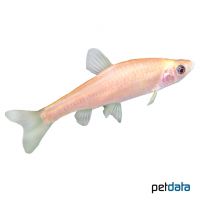Golden Topmouth Gudgeon (Pseudorasbora parva 'Gold')
| Golden Topmouth Gudgeon Pseudorasbora parva 'Gold' | |
|---|---|
| Name | Golden Topmouth Gudgeon |
| Name Lat. | Pseudorasbora parva 'Gold' |
| Family | Gudgeons |
| Family lat. | Gobionidae |
| Order | Carps |
| Order lat. | Cypriniformes |
| Origin | Asia |
| Habitat | Streams, rivers, lakes |
| Diet | Omnivore |
| pH | 6.5-7.5 |
| Behavior | Peaceful |
| Keeping | Group |
| Care Level | Easy |
| Reproduction | Substrate spawner |
| Breeding | Moderately difficult |
| Life Span | 3-5 years |
| Protection | No |
| Metric Units | |
| Size | 6-10 cm |
| Temperature | 4-26 °C |
| Hardness | < 20 °dH |
| Aquarium | ~ 200 l or ponds |
| US Units | |
| Size | 2.5"-4" |
| Temperature | 39-79 °F |
| Hardness | < 356 ppm |
| Aquarium | ~ 50 gal or ponds |
Distribution and habitat
The golden blue danio is a breeding form. The distribution area of the blue danios was originally in East Asia, between the Amur region in Siberia to China and Korea. They were introduced into many areas of northern Europe up to the Danube, where they colonize rivers, lakes, impounded waters, waters in sand pits and fish ponds with very high concentrations of plant plankton.
Maintenance
The pond should be furnished with pond, floating and especially oxygenating underwater plants (milfoil, waterweed, hornwort, etc.), large river pebbles, and a substrate of sand and round-grained gravel, and provide plenty of free swimming space.
When maintaining in a cold water aquarium, make sure that there is plenty of swimming space in addition to dense perimeter planting and plenty of hiding places (roots, rocks). A soft substrate, oxygen-rich water and slightly shaded light (floating plants) is ideal
No ammonia, ammonium and nitrite should be detectable in the water, the nitrate value should not exceed 100 mg/l. To ensure the water quality and oxygen content should not be missing a filter adapted to the water volume.
Diet
They feed mainly on phytoplankton and insects. The food supply consists mainly of commercially available special dry food for pond fish (flakes, sticks, granules) supplemented with live food, such as daphnia, tubifex or mosquito larvae, which is also accepted without problems in frozen form. In addition, they need plant food, such as aquatic plants (Rizzia flutians, etc.) or dry food with high vegetable content (spirulina)
Behaviour and compatibility
These calm and sociable fish do not exhibit any aggressive or incompatible behaviors. At least 5, but preferably much more blue danios should be kept together. They can be socialized well with other peaceful pond fish, such as gudgeon, orf, etc. Basically, only compatible fish species with similar demands on water condition and water temperature should be socialized.
Reproduction and breeding
The sexes are difficult to distinguish. At spawning time, the males have a spawning rash and the females appear rounder.
Females spawn between March and June, at water temperatures of 18-20 °C. The sticky eggs are attached to aquatic plants in spawning strings and guarded by the male for about 1 week until the larvae hatch. The fry grow quickly and are mature and sexually mature after only one year.
Important
Attention: EU-DVO 2016/1141 Invasive species
Bluebanded danios make clearly audible clicking sounds. They are well suited to fight algae in the pond and leave aquatic plants largely unharmed.
If they are overwintered in the pond, sufficient depth and oxygen supply (filter, oxygen dispenser, ice free holder) must be ensured
At temperatures below 8-10 °C, the metabolism of the fish slows down and no more food is accepted; feeding must be stopped accordingly. If the temperature drops further, they hibernate near the bottom. In spring, with rising temperatures, feeding can slowly be resumed. Feeding may also be necessary during prolonged warm periods in winter.
The well-being of the fish should be monitored regularly. A regular partial water change, according to the pond size is recommended, even if the pollutant load has not yet reached the upper limit. Sudden changes in water quality should be avoided. Newly introduced fish must be accustomed slowly to the water in the pond or aquarium
Further literature can be found in your pet store.
References
Text: petdata; Image: petdata
Source: BMELV (1998): Tierschutzgutachten - Haltung von Zierfischen (Süßwasser); BAENSCH & RIEHL (2006): Aquarien Atlas Bd. 2, Mergus Verlag; ENGELMANN (2005): Zootierhaltung - Tiere in menschlicher Obhut: Fische; Harri Deutsch Verlag
- Gemäß § 21 Abs. 5 Tierschutzgesetz idgF
